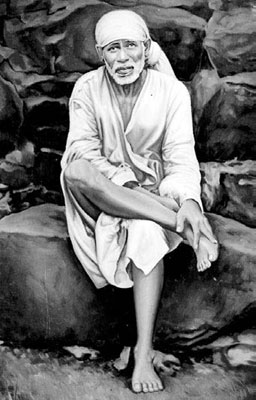
this mosque will never
come to an evil end, even
to the end of this world."
--Sri Sai Baba
On the eastern wall, opposite the steps leading up to the dhuni, hangs a large framed picture of what is probably the most famous image of Baba. It is a painting of an original black-and-white photograph.
Baba is seated on a large stone with his right leg crossed over the left thigh, his left hand resting on the crossed foot. He is wearing a torn kafni, a headscarf knotted over his left shoulder, and he sits relaxed yet alert, leaning forward slightly. His expression is at once intense, all-knowing and compassionate, but above all, unfathomable. To Sai devotees, this is probably the most familiar image of Baba. Consequently, many believe that this posture was a common one of Baba's. Some suggest that Baba adopted this pose deliberately, as in Indian iconography it represents sovereignty, and is associated with gods and maharajahs (and some draw parallels with Dakshinamurti who also sits facing south with one leg crossed over the other). Others say that it has no special significance and that it was not Baba's typical posture. Whatever the facts, the picture is treasured by Sai devotees as one of only six or seven photos that we have of Baba.
Until Baba sat on it, the stone was used by devotees for washing their clothes (remember that in those days, the mosque consisted of only the raised area around the dhuni, so the stone was outside). One day Baba happened to sit down on it and someone took the opportunity to photograph him. Once he had sat on it, the stone was considered sacred and no longer used for washing. It is that stone, set with a pair of marble padukas, which is now under Baba's photo. The owner of the original painting of this photo, D. D. Neroy from Bombay, gave the painting to his guru, Kammu Baba, who later gave it to the Sansthan. It is likely that this was the picture that the Sansthan gave as a model to the sculptor who carved Baba's statue for the Samadhi Mandir.
Devotees meditate on and worship this picture. Baba has said that there is no difference between his physical self and his image. Indeed, he even proved this on a number of occasions. When Balabua Sutar came to see Baba for the first time in 1917, Baba said that he had known him for four years. This puzzled Sri Sutar, but then he remembered that he had prostrated before a picture of Baba in Bombay four years previously, and it was that to which Baba was alluding. Even more dramatically, Baba once came to Hemadpant in a vision and told him he would be coming for lunch that full moon festival day. In an extraordinary chain of events, a picture of Baba was unexpectedly delivered to Hemadpant's house just as the midday meal was about to be served!

